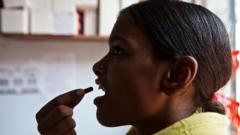India grapples with a severe antimicrobial resistance crisis, with a study indicating a staggering treatment gap for carbapenem-resistant infections. Despite high antibiotic procurement, only a fraction of patients receive effective treatment, highlighting systemic access issues and necessitating urgent infrastructural reforms.
Antimicrobial Resistance Crisis Deepens in India as Access to Vital Antibiotics Wanes

Antimicrobial Resistance Crisis Deepens in India as Access to Vital Antibiotics Wanes
A new study reveals that while antibiotics are misused, millions in India lack access to effective treatments for deadly superbugs.
India is facing a dual crisis of antimicrobial resistance, as more people are succumbing to infections that could potentially be treated with accessible antibiotics, according to a new study by the Global Antibiotic Research and Development Partnership (GARDP). This research scrutinizes the access to antibiotics among approximately 1.5 million cases of carbapenem-resistant Gram-negative (CRGN) infections across eight low- and middle-income nations, revealing alarming disparities, particularly in India.
Despite the overuse of antibiotics leading to widespread resistance, the study highlights that only 6.9% of patients in the surveyed countries received adequate treatment. India, being the hardest hit, accounted for a staggering 80% of the full courses of antibiotics but managed to treat only 7.8% of its estimated CRGN infections, as reported in The Lancet Infectious Diseases journal. Health experts warn that the presence of Gram-negative bacteria in water, food, and healthcare facilities poses severe risks, particularly for newborns and immunocompromised individuals.
Dr. Abdul Gaffar from Apollo Hospital in Chennai described the grim reality: "We often see patients for whom no antibiotic works—and they die." The paradox remains that while global efforts focus on curbing antibiotic overuse, those in need are left untreated due to inadequate access to life-saving drugs.
The study reviewed eight intravenous medications for carbapenem-resistant bacteria, from older options like Colistin to newer treatments such as Ceftazidime-avibactam. Researchers point out that barriers like underdeveloped healthcare systems, expensive medications, and a lack of diagnostics play critical roles in this crisis. Although drugs like Tigecycline are in limited supply, only 103,647 treatment courses were procured in the eight countries, far fewer than necessary.
The stark contrast in access suggests that wealthier patients often misuse antibiotics, while poorer populations are left without treatment. To mitigate these challenges, Dr. Gaffar emphasizes the need for regulatory frameworks requiring oversight on prescriptions and ensuring equitable access.
Moreover, the decline in antibiotic research and development globally further exacerbates this situation. However, researchers believe that India can position itself as a leader in combating antimicrobial resistance. With significant pharmaceutical resources, local data generation, and innovative health models, India could help bridge the treatment gap for infectious diseases.
Improving antibiotic access is critical, as lack of availability threatens modern medical practices including surgery and cancer treatment. The challenge ahead lies not only in the prudent use of existing antibiotics but also in ensuring that the most vulnerable populations receive the necessary treatments they desperately need.




















